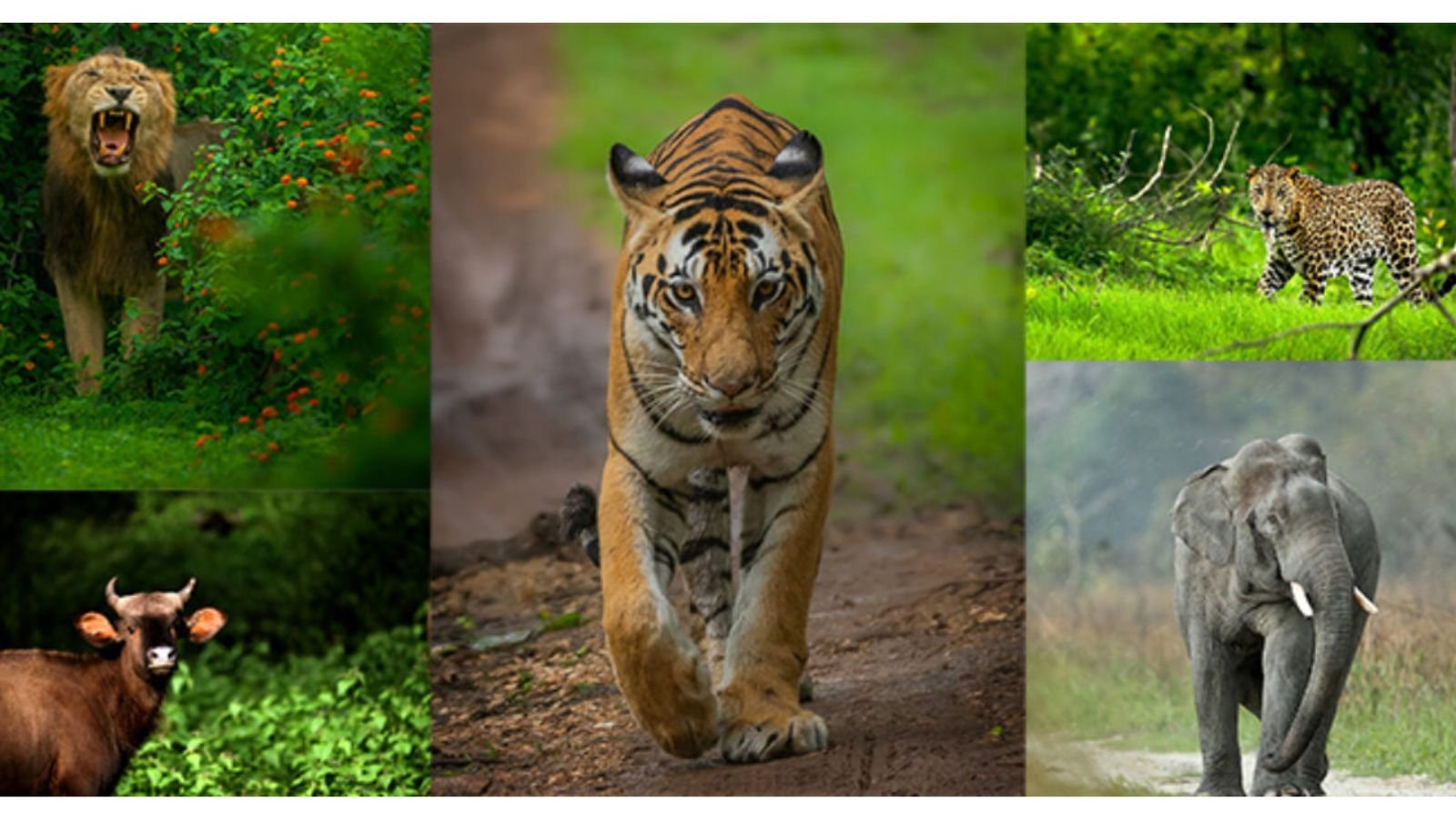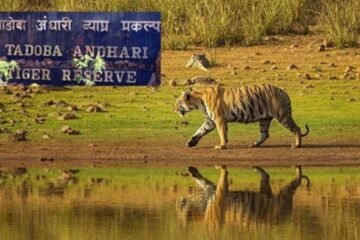1. Jim Corbett National Park
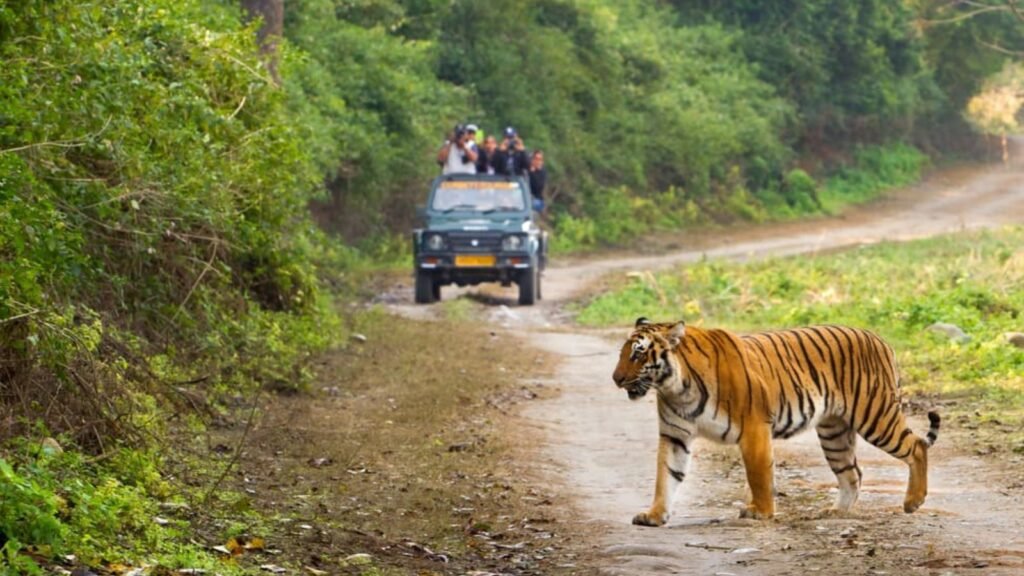
Jim Corbett National Park, originally known as Hailey National Park, is a famous wildlife sanctuary and national park located in the Indian state of Uttarakhand. Established in 1936, it is one of the oldest national parks in India and covers an area of approximately 520 square kilometers (200 square miles). The park is named after the renowned British hunter and conservationist Jim Corbett, who played a significant role in the establishment of the park and in the conservation of its wildlife.
Here are some key features and information about Jim Corbett National Park:
- Wildlife: The park is known for its rich biodiversity and is home to a wide variety of wildlife, including the Bengal tiger, Indian elephant, leopard, sloth bear, various species of deer, and numerous bird species. It’s one of the best places in India to spot tigers in their natural habitat.
- Landscape: Jim Corbett National Park is situated in the foothills of the Himalayas, and its landscape includes dense forests, grasslands, rivers, and hills. The Ramganga River flows through the park, providing a water source for the animals.
- Safari: Visitors can explore the park through safari tours, which are available in different zones of the park. Jeep safaris and elephant safaris are popular options for wildlife enthusiasts. These safaris offer the opportunity to observe and photograph the park’s diverse flora and fauna.
- Bird Watching: The park is a paradise for bird watchers, with over 600 species of birds, making it an important destination for ornithologists. Commonly spotted birds include crested serpent eagles, white-rumped vultures, and many waterfowl species.
- Flora: The park is home to a variety of plant species, including sal forests, grasslands, and various types of trees and shrubs. The park’s flora supports its diverse wildlife.
- Conservation: Jim Corbett National Park plays a crucial role in the conservation of the Bengal tiger and other endangered species. Conservation efforts in the park aim to protect and preserve the natural habitat and wildlife.
- Accommodation: There are various accommodation options within and around the park, ranging from luxury resorts to budget hotels and forest rest houses. Dhikala, Bijrani, and Jhirna are some of the popular tourist zones within the park where accommodations are available.
- Best Time to Visit: The park is open for tourists from November to June, with the best time to visit being from November to February when the weather is cooler. The park remains closed during the monsoon season (July to October) due to heavy rains.
Jim Corbett National Park is not only a great destination for wildlife enthusiasts but also an important site for wildlife conservation efforts in India. It offers visitors a chance to connect with nature and witness the beauty of India’s wildlife in its natural habitat.
2. Ranthambore National Park
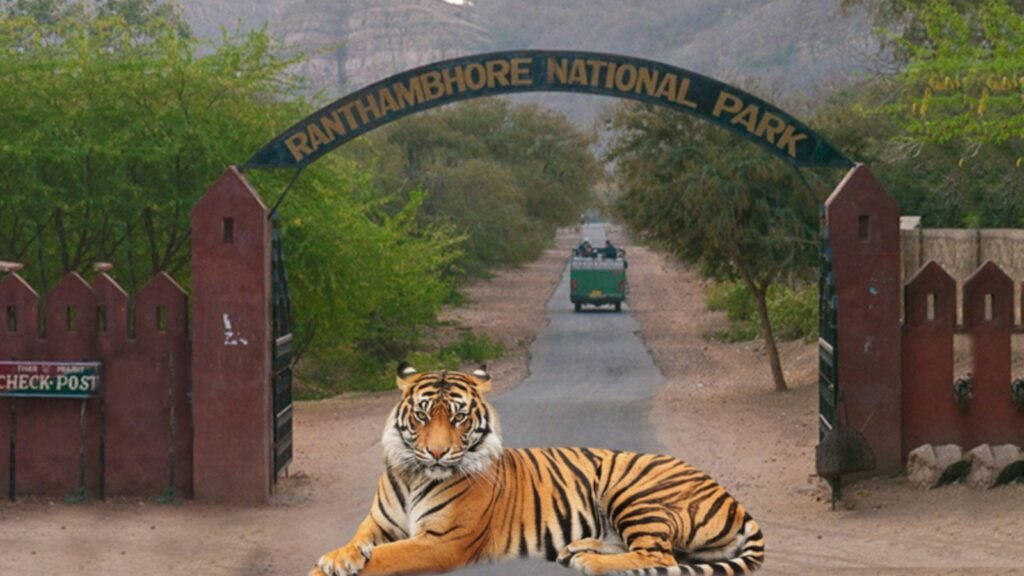
Ranthambore National Park is one of India’s most famous and prominent national parks and wildlife sanctuaries. Located in the state of Rajasthan in northern India, Ranthambore is renowned for its rich biodiversity and, in particular, its population of Bengal tigers. Here are some key features and information about Ranthambore National Park:
- Wildlife: Ranthambore National Park is primarily known for its population of Bengal tigers. It was originally established as the Sawai Madhopur Game Sanctuary in 1955 and later declared a national park in 1980. Apart from tigers, the park is home to various other wildlife species, including leopards, sloth bears, wild boars, sambar deer, spotted deer (chital), Indian gazelles (chinkara), and numerous bird species.
- Landscape: The park’s terrain consists of dry deciduous forests, rocky hills, and open grassy meadows. The park’s most iconic feature is the Ranthambore Fort, a UNESCO World Heritage Site, which overlooks the park and adds historical and architectural significance to the area.
- Tiger Safaris: Visitors to Ranthambore can explore the park’s wildlife and natural beauty through guided safari tours. The park is divided into several zones, and these safaris offer a chance to spot tigers, along with other wildlife, in their natural habitat. Jeep safaris and canter safaris (open-air vehicles) are popular options.
- Bird Watching: Ranthambore is also known for its diverse birdlife. The park hosts numerous resident and migratory bird species, making it a great destination for bird watchers. Some of the common bird species found here include peafowls, owls, eagles, and various waterfowl species.
- Best Time to Visit: The best time to visit Ranthambore National Park is from October to June when the park is open to tourists. The park remains closed during the monsoon season (July to September) due to heavy rainfall. The cooler months of winter (November to February) are particularly popular for wildlife sightings.
- Accommodation: There are various accommodation options available near Ranthambore National Park, ranging from luxury resorts to budget hotels and forest lodges. Booking accommodations in advance, especially during the peak tourist season, is advisable.
- Conservation: Ranthambore National Park plays a crucial role in the conservation of Bengal tigers and other wildlife species. Conservation efforts focus on protecting the habitat and ensuring the survival of these endangered animals.
Ranthambore National Park’s combination of wildlife, historical significance, and natural beauty makes it a popular destination for both wildlife enthusiasts and tourists interested in India’s rich cultural heritage.
3. Tadoba Wildlife Sanctury
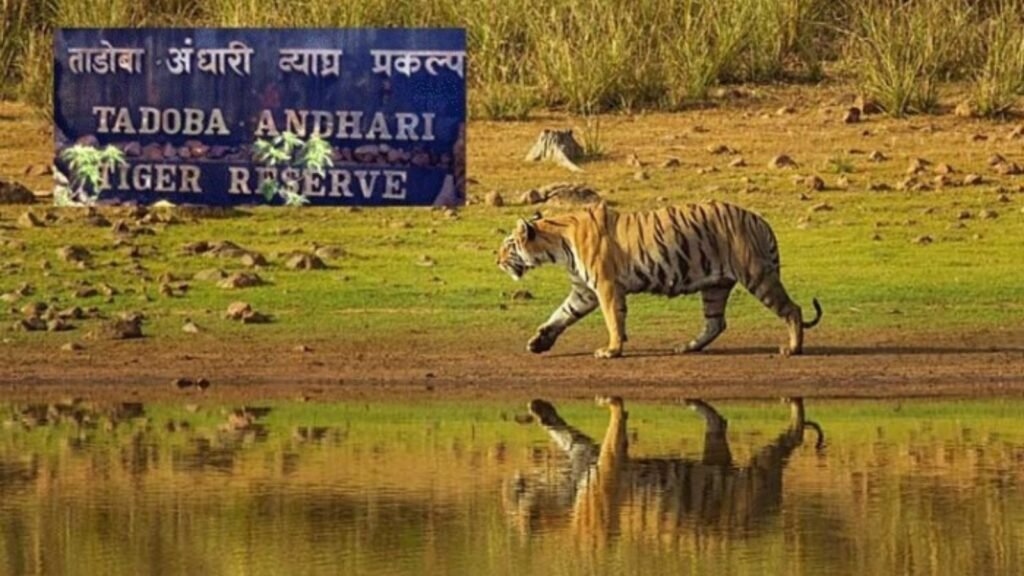
Tadoba Andhari Tiger Reserve, often referred to as Tadoba Wildlife Sanctuary, is one of the prominent tiger reserves and wildlife conservation areas in the Indian state of Maharashtra. It is situated in the Chandrapur district in the central part of the country. Tadoba is known for its rich biodiversity, including a significant population of Bengal tigers. Here’s some important information about Tadoba Wildlife Sanctuary:
- Wildlife: Tadoba Andhari Tiger Reserve is renowned for its Bengal tiger population. Apart from tigers, the reserve is home to various other wildlife species, including leopards, sloth bears, Indian bison (gaur), wild dogs (dholes), sambar deer, spotted deer (chital), Indian gazelles (chinkara), and many species of birds and reptiles.
- Landscape: The landscape of Tadoba is characterized by dense forests, grasslands, hills, and several water bodies. The Andhari River meanders through the reserve, providing a vital water source for wildlife.
- Tiger Safaris: Visitors can explore Tadoba Andhari Tiger Reserve through jeep safaris and canter safaris. These safaris offer a chance to spot tigers and other wildlife species in their natural habitat. The park is divided into multiple zones, each with its own entry gate and unique characteristics.
- Bird Watching: Tadoba is a haven for bird watchers. The reserve hosts a diverse range of bird species, making it an excellent destination for bird enthusiasts. Some of the common bird species found here include Indian pitta, crested serpent eagle, and various waterfowl.
- Best Time to Visit: The best time to visit Tadoba Wildlife Sanctuary is from October to June when the park is open to tourists. The park is typically closed during the monsoon season (July to September) due to heavy rainfall.
- Accommodation: There are accommodations available in and around Tadoba Tiger Reserve, including resorts, lodges, and government guesthouses. It’s advisable to book accommodations in advance, especially during the peak tourist season.
- Conservation: Tadoba Andhari Tiger Reserve is dedicated to the conservation and protection of Bengal tigers and their habitat. Conservation efforts focus on safeguarding the park’s ecosystem and ensuring the survival of these endangered big cats.
Tadoba Wildlife Sanctuary is known for its relatively undisturbed and pristine natural environment, making it an excellent destination for wildlife enthusiasts and photographers. The opportunity to see Bengal tigers and other wildlife in their natural habitat draws visitors from all over the world, contributing to the conservation efforts in the region.
4. Bandhavgarh National Park

Bandhavgarh National Park is one of the most well-known and popular national parks in India, located in the Umaria district of Madhya Pradesh. It is celebrated for its high density of Bengal tigers and is regarded as one of the best places in India to spot these majestic creatures in their natural habitat. Here are some key features and information about Bandhavgarh National Park:
- Wildlife: Bandhavgarh is primarily known for its Bengal tiger population, and it has one of the highest tiger densities in India. Apart from tigers, the park is home to other wildlife species such as leopards, sloth bears, Indian bison (gaur), sambar deer, spotted deer (chital), Indian gazelles (chinkara), wild boars, and various bird species.
- Landscape: The park’s landscape comprises a mix of dense forests, steep cliffs, rocky hills, and grassy meadows. The centerpiece of the park is the ancient Bandhavgarh Fort, perched on a hill and adding historical and architectural significance to the area.
- Tiger Safaris: Visitors can explore Bandhavgarh National Park through jeep safaris and canter safaris. These guided tours offer an opportunity to spot tigers and other wildlife species. The park is divided into multiple zones, each with its own entry gate, and safari permits are required.
- Bird Watching: The park is a paradise for bird enthusiasts, with over 250 species of birds recorded. Bird watchers can spot a wide range of avian species, including vultures, eagles, owls, and various migratory birds.
- Best Time to Visit: The best time to visit Bandhavgarh National Park is from October to June, when the park is open for tourists. The park is typically closed during the monsoon season (July to September) due to heavy rainfall.
- Accommodation: There are several accommodation options available near Bandhavgarh, including wildlife resorts, lodges, and forest rest houses. It is advisable to make advance reservations, especially during the peak tourist season.
- Conservation: Bandhavgarh National Park is committed to the conservation of Bengal tigers and their habitat. Conservation efforts include protecting the park’s ecosystem and ensuring the survival of these endangered big cats.
The combination of its remarkable tiger population, diverse wildlife, and the historical significance of Bandhavgarh Fort make this national park a sought-after destination for wildlife enthusiasts, photographers, and nature lovers. It offers a unique opportunity to witness the beauty of the Indian wilderness while supporting crucial tiger conservation efforts.
5. Kanha National Park
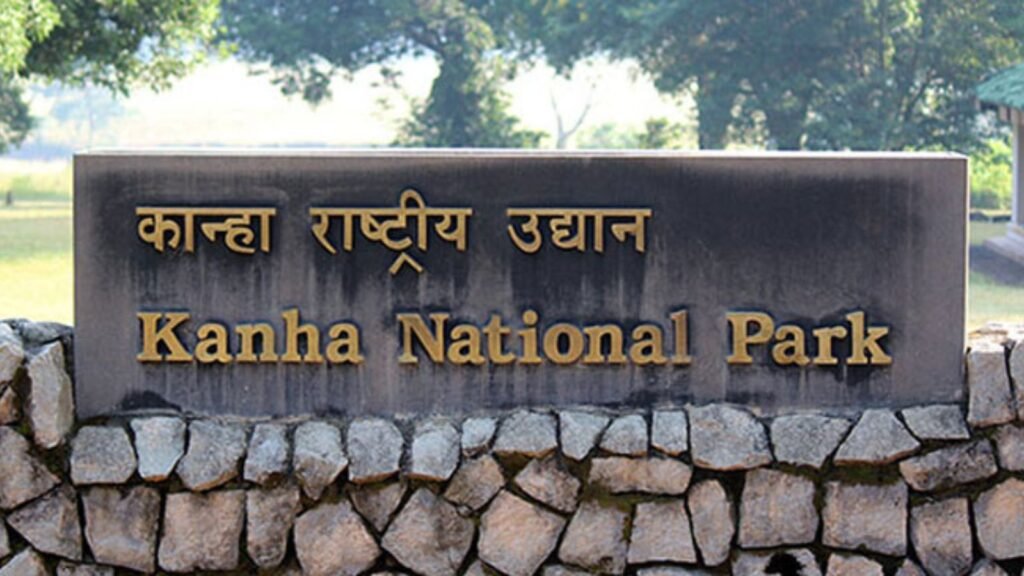
Kanha National Park is one of the most well-known and significant national parks in India, located in the Maikal Hills of the Satpura Range in the state of Madhya Pradesh. It is renowned for its rich biodiversity, particularly its population of Bengal tigers and the successful conservation efforts that have taken place within the park. Here are some key features and information about Kanha National Park:
- Wildlife: Kanha National Park is famous for its Bengal tigers, and it is one of the best places in India to spot these magnificent big cats. In addition to tigers, the park is home to a diverse array of wildlife, including leopards, sloth bears, Indian bison (gaur), Indian wild dogs (dholes), sambar deer, spotted deer (chital), Indian gazelles (chinkara), and numerous bird species.
- Landscape: The park’s terrain consists of a mix of dense forests, open grassy meadows, streams, and picturesque plateaus. The Banjaar River flows through the park, providing a vital water source for the wildlife.
- Tiger Safaris: Visitors can explore Kanha National Park through jeep safaris and canter safaris. These guided tours offer an opportunity to observe tigers and other wildlife in their natural habitat. The park is divided into multiple zones, each with its own entry gate, and permits are required for safaris.
- Bird Watching: Kanha is a haven for birdwatchers, with over 300 bird species recorded within the park. Bird enthusiasts can spot a wide variety of avian species, including raptors, waterfowl, and forest birds.
- Best Time to Visit: The best time to visit Kanha National Park is from October to June when the park is open for tourists. The park typically closes during the monsoon season (July to September) due to heavy rainfall.
- Accommodation: There are several accommodation options available near Kanha, including wildlife resorts, lodges, and government-run guesthouses. It is advisable to make advance reservations, especially during the peak tourist season.
- Conservation: Kanha National Park has been instrumental in the conservation of Bengal tigers and other wildlife species. Conservation efforts focus on preserving the park’s ecosystem, minimizing human-wildlife conflict, and ensuring the survival of these endangered animals.
Kanha National Park’s combination of remarkable wildlife diversity, lush landscapes, and successful conservation programs make it a sought-after destination for wildlife enthusiasts, photographers, and nature lovers. It offers a unique opportunity to witness the beauty of the Indian wilderness while supporting crucial tiger conservation efforts.
6. Pench National Park

Pench National Park is a prominent wildlife sanctuary and national park located in central India, straddling the border between the states of Madhya Pradesh and Maharashtra. The park is known for its rich biodiversity, including a variety of wildlife species and lush forests. Here’s some key information about Pench National Park:
- Wildlife: Pench National Park is famous for its diverse wildlife. It is home to a significant population of Bengal tigers, making it one of the key tiger reserves in India. Other notable wildlife species in the park include leopards, sloth bears, Indian bison (gaur), sambar deer, spotted deer (chital), Indian gazelles (chinkara), and various bird species.
- Landscape: The park’s landscape comprises a mix of tropical moist deciduous forests, open grasslands, and several water bodies. The Pench River flows through the park, providing a vital water source for the wildlife.
- Tiger Safaris: Visitors can explore Pench National Park through jeep safaris and canter safaris. These guided tours offer an opportunity to spot tigers and other wildlife species in their natural habitat. The park is divided into multiple zones, and permits are required for safaris.
- Bird Watching: Pench is also known for its avian diversity, making it a great destination for bird enthusiasts. The park is home to various resident and migratory bird species, including peafowls, owls, eagles, and waterfowl.
- Best Time to Visit: The best time to visit Pench National Park is from October to June when the park is open to tourists. The park is typically closed during the monsoon season (July to September) due to heavy rainfall.
- Accommodation: There are several accommodation options available near Pench National Park, including wildlife resorts, lodges, and government-run guesthouses. It’s advisable to make advance reservations, especially during the peak tourist season.
- Conservation: Pench National Park is dedicated to the conservation of Bengal tigers and their habitat. Conservation efforts aim to protect the park’s ecosystem, minimize human-wildlife conflict, and ensure the survival of these endangered big cats.
Pench National Park’s combination of abundant wildlife, lush landscapes, and successful conservation initiatives make it a popular destination for wildlife enthusiasts, photographers, and nature lovers. It offers a chance to witness the beauty of the Indian wilderness while contributing to the protection of these magnificent creatures.
7. Gir Wildlife Sanctury
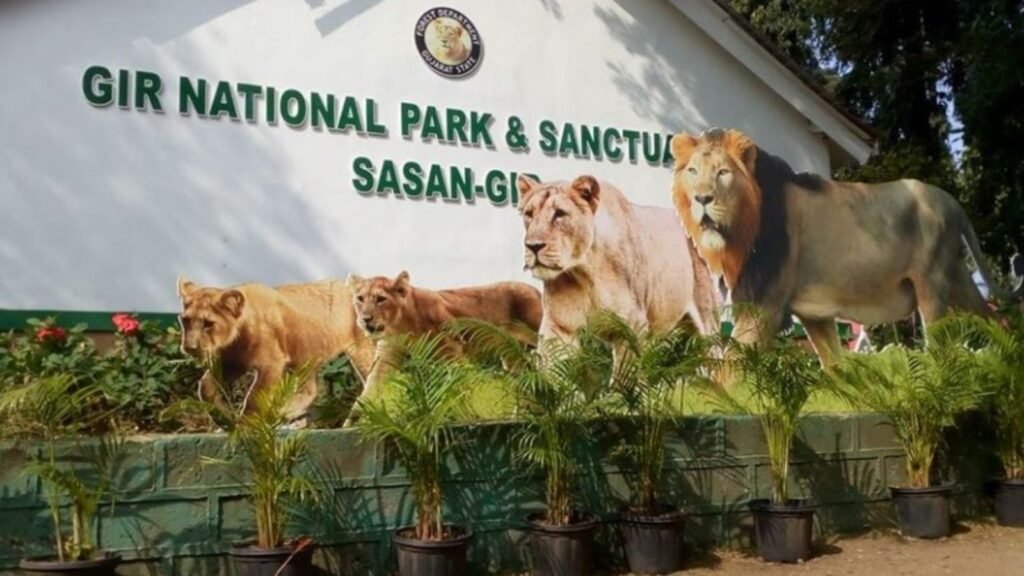
Gir Wildlife Sanctuary, also known as the Gir Forest National Park, is a renowned wildlife sanctuary located in the western state of Gujarat, India. It is celebrated as the last refuge of the Asiatic lion, one of the world’s most endangered big cat species. Here are some key features and information about Gir Wildlife Sanctuary:
- Wildlife: The primary draw of Gir Wildlife Sanctuary is the Asiatic lion (Panthera leo persica), a subspecies of lion that once ranged across much of southwestern Asia but now has its last surviving wild population in this region. Apart from lions, the sanctuary is home to other wildlife species, including leopards, Indian bison (gaur), sloth bears, sambar deer, spotted deer (chital), Indian gazelles (chinkara), and various bird species.
- Landscape: The sanctuary’s terrain includes deciduous forests, scrubland, grassy plains, and rocky hills. It is also crisscrossed by seasonal rivers and streams.
- Conservation Success: Gir Wildlife Sanctuary has been instrumental in the successful conservation of the Asiatic lion. The sanctuary’s population of lions has been steadily increasing over the years, thanks to conservation efforts and strict protection measures.
- Safari: Visitors can explore Gir Wildlife Sanctuary through jeep safaris and lion safaris, which are the primary means to see lions and other wildlife in their natural habitat. The park is divided into different zones, and permits are required for safaris.
- Bird Watching: Gir is also a good destination for birdwatchers, with a variety of bird species to be found. Some common species include Indian vultures, crested serpent eagles, and various waterfowl.
- Best Time to Visit: The best time to visit Gir Wildlife Sanctuary is from November to June when the park is open for tourists. The park typically remains closed during the monsoon season (July to October) due to heavy rains.
- Accommodation: There are several accommodation options available near Gir Wildlife Sanctuary, including forest lodges, resorts, and hotels. It is advisable to make advance reservations, especially during the peak tourist season.
- Conservation: Conservation efforts in Gir focus on the protection of the Asiatic lion and its habitat. The park management works to minimize human-lion conflict and ensure the long-term survival of this endangered species.
Gir Wildlife Sanctuary is a significant conservation area and a remarkable destination for wildlife enthusiasts and photographers interested in the critically endangered Asiatic lion. It offers a unique opportunity to witness these majestic big cats in their natural environment while contributing to their conservation and the preservation of their habitat.
8. Kuno National Park
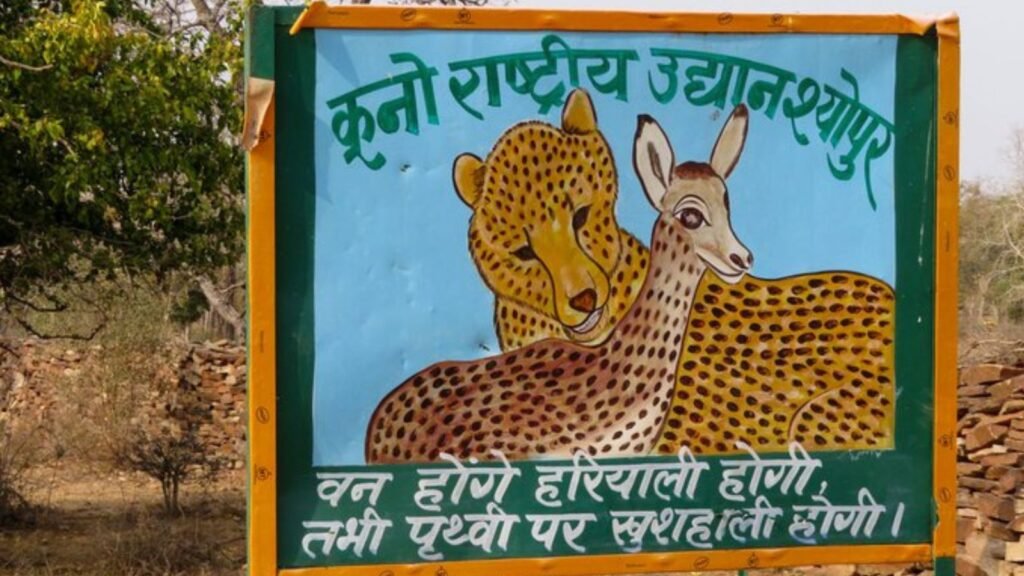
Kuno National Park is a protected area located in the Sheopur and Morena districts of the Indian state of Madhya Pradesh. It is notable for its role in the relocation and reintroduction of Asiatic lions, with the aim of establishing a second home for this critically endangered big cat species, apart from their existing population in Gir Forest National Park in Gujarat. Here are some key features and information about Kuno National Park:
- Wildlife: The primary objective of Kuno National Park is the reintroduction and conservation of the Asiatic lion (Panthera leo persica). Apart from lions, the park is home to other wildlife species such as leopards, sloth bears, Indian bison (gaur), sambar deer, spotted deer (chital), Indian gazelles (chinkara), and various bird species.
- Landscape: The park’s terrain includes a mix of forests, grasslands, and rocky hills. The Kuno River flows through the park, providing water to the wildlife.
- Lion Relocation: The Indian government and various wildlife conservation organizations have been working towards relocating a population of Asiatic lions from the Gir Forest in Gujarat to Kuno National Park as a measure to ensure the long-term survival of the species. The idea is to establish a second viable population of Asiatic lions in a different geographic location.
- Safari: Visitors can explore Kuno National Park through jeep safaris and other guided tours. While the park’s primary focus is on lion conservation, it also offers opportunities to observe other wildlife and the natural beauty of the region.
- Bird Watching: Kuno is a good destination for birdwatchers, with a variety of bird species to be found, including both resident and migratory birds.
- Best Time to Visit: The best time to visit Kuno National Park is typically from October to June when the park is open for tourists. Like many other Indian national parks, Kuno remains closed during the monsoon season (July to September) due to heavy rains.
- Accommodation: Accommodation options near Kuno National Park include forest lodges, resorts, and guesthouses. It is advisable to make advance reservations, especially during the peak tourist season.
- Conservation: Conservation efforts in Kuno National Park focus on the reintroduction and protection of the Asiatic lion population, as well as the preservation of the park’s ecosystem.
Kuno National Park holds great significance in the context of Asiatic lion conservation in India. The successful relocation and establishment of a second population of these majestic big cats in Kuno would contribute significantly to their long-term survival and genetic diversity, reducing the risk of catastrophic events affecting a single population.
9. Kaziranga National Park

Kaziranga National Park is a renowned wildlife sanctuary and UNESCO World Heritage Site located in the northeastern state of Assam, India. It is celebrated for its exceptional biodiversity and is best known for its population of the Indian one-horned rhinoceros. Here are some key features and information about Kaziranga National Park:
- Wildlife: Kaziranga is famous for its significant population of the Indian one-horned rhinoceros (Rhinoceros unicornis), which is one of the world’s most endangered species. It is estimated that over two-thirds of the world’s one-horned rhinoceros population resides in Kaziranga. In addition to rhinoceroses, the park is home to a wide variety of wildlife, including Bengal tigers, Indian elephants, wild water buffalo, swamp deer (barasingha), leopards, sloth bears, sambar deer, Indian muntjac, Indian bison (gaur), and numerous bird species.
- Landscape: The landscape of Kaziranga comprises extensive grasslands, wetlands, marshes, and forests. The park is situated in the floodplains of the Brahmaputra River, and its topography is shaped by the annual monsoon floods.
- Conservation: Kaziranga National Park is dedicated to the conservation and protection of the Indian one-horned rhinoceros and other wildlife species. It has been instrumental in the successful recovery of the rhinoceros population, which was once critically endangered due to rampant poaching.
- Safari: Visitors can explore Kaziranga National Park through various safari options, including elephant safaris and jeep safaris. These guided tours offer opportunities to observe the park’s wildlife, including rhinoceroses, tigers, and elephants.
- Bird Watching: Kaziranga is also a renowned birdwatching destination, with over 500 bird species recorded within the park. Some notable bird species include the great Indian hornbill, Bengal florican, and a variety of waterfowl.
- Best Time to Visit: The best time to visit Kaziranga National Park is from November to April when the park is open for tourists. The park is typically closed during the monsoon season (May to October) due to heavy flooding.
- Accommodation: There are several accommodation options available near Kaziranga National Park, including wildlife resorts, lodges, and government-run guesthouses. It is advisable to make advance reservations, especially during the peak tourist season.
- Community Involvement: Kaziranga’s conservation efforts often involve the local communities living around the park. Programs aimed at reducing human-wildlife conflict and supporting sustainable livelihoods for the local population are implemented.
Kaziranga National Park’s unique combination of extraordinary biodiversity, including the iconic Indian one-horned rhinoceros, and its scenic beauty make it a premier wildlife destination in India. It offers visitors a chance to witness the beauty of the Indian wilderness and actively contribute to the conservation of endangered species.
10. Nagarahole National Park
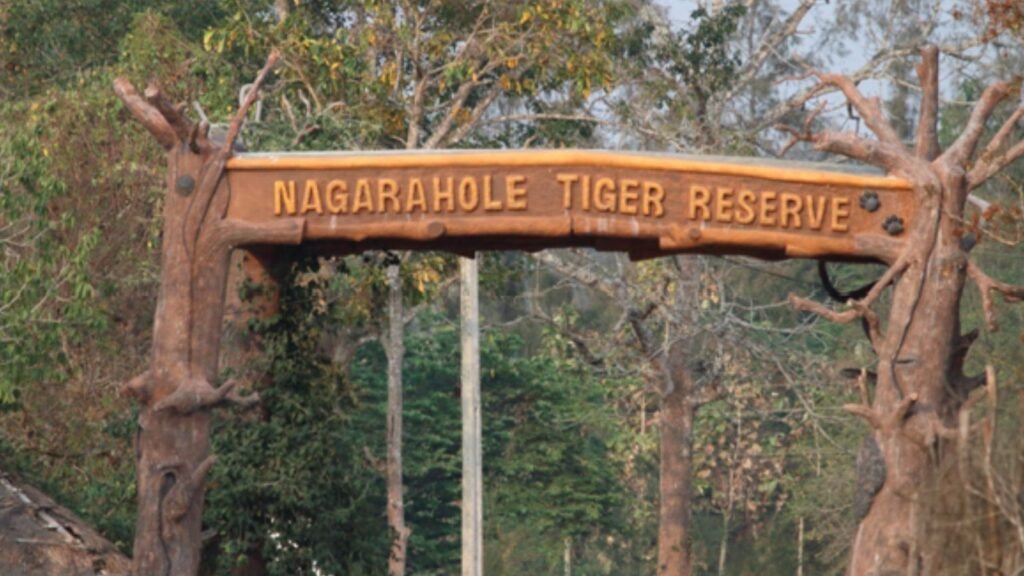
Nagarahole National Park, also known as Rajiv Gandhi National Park, is a prominent wildlife sanctuary and national park located in the southwestern state of Karnataka, India. It is part of the Nilgiri Biosphere Reserve and is known for its rich biodiversity, dense forests, and diverse wildlife. Here are some key features and information about Nagarahole National Park:
- Wildlife: Nagarahole National Park is renowned for its diverse wildlife. Some of the prominent species found in the park include Bengal tigers, Indian elephants, Indian bison (gaur), leopards, sloth bears, sambar deer, spotted deer (chital), Indian gazelles (chinkara), and numerous bird species. The park is also known for its healthy population of wild dogs (dholes).
- Landscape: The park’s landscape consists of dense forests, grassy meadows, and several seasonal streams and rivers. The park’s name, “Nagarahole,” means “snake river” in the local language, referring to the winding course of the Kabini River that flows through the area.
- Safari: Visitors can explore Nagarahole National Park through safari tours, including jeep safaris and boat safaris on the Kabini River. These guided tours offer excellent opportunities to spot wildlife, including tigers and elephants.
- Bird Watching: Nagarahole is a great destination for bird enthusiasts, with over 270 bird species recorded within the park. Some notable bird species include the Malabar trogon, Indian pitta, and various waterfowl.
- Best Time to Visit: The best time to visit Nagarahole National Park is from October to June when the park is open for tourists. The park typically remains closed during the monsoon season (July to September) due to heavy rainfall.
- Accommodation: There are accommodation options available within and around Nagarahole National Park, including forest lodges, wildlife resorts, and government-run guesthouses. It’s advisable to make advance reservations, especially during the peak tourist season.
- Conservation: Nagarahole National Park is dedicated to the conservation and protection of its diverse wildlife. Conservation efforts aim to preserve the park’s ecosystem and ensure the survival of endangered and vulnerable species.
- Community Involvement: The park management often involves local communities in conservation efforts, including programs to reduce human-wildlife conflict and promote sustainable livelihoods for the local population.
Nagarahole National Park’s combination of remarkable biodiversity, lush landscapes, and successful conservation initiatives make it an attractive destination for wildlife enthusiasts, photographers, and nature lovers. It offers a unique opportunity to experience the beauty of the Indian wilderness while supporting vital conservation efforts.



